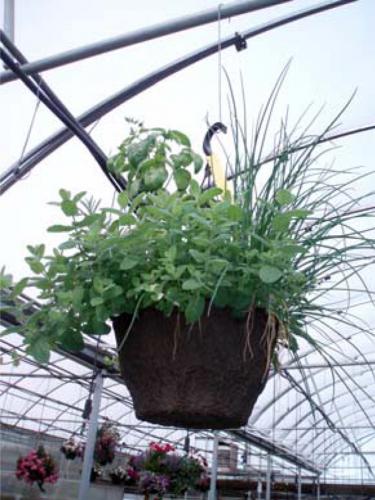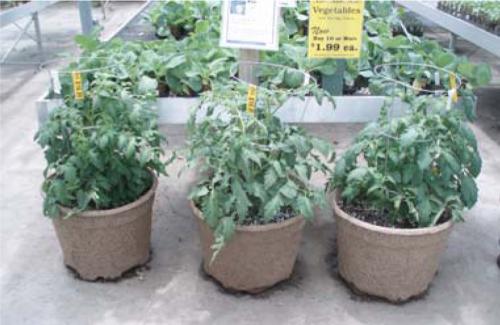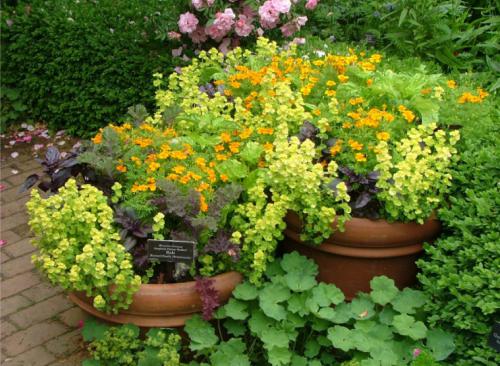
Container gardening with vegetables & herbs tip sheet
DOWNLOADAugust 25, 2016
Nothing tastes as good as fresh produce. It tastes even better when you pick it in your own garden. What if you don’t have much space or no yard? You can have some vegetables and herbs growing on a sunny patio, porch, or deck in containers. A few minutes of planning and preparation will improve your success and enjoyment of any container garden.
Site selection
Vegetables and herbs need to be placed in a location with at least six hours of sunlight each day. Shade from overhangs, buildings or furniture will decrease the total number of hours the container receives sunlight, so take that into consideration. Without enough sun, there won’t be much production.
Container selection
The most important part of container selection is to find a container that has sufficient drainage holes in the bottom. Anything, in theory, can be a container from boots to wagons to tires. A good container has numerous small holes, ideally quarter-inch holes every two to three inches of container bottom. One large hole does not permit as much drainage as numerous small holes.
Material
Plastic containers are lighter in weight and can be more easily moved from one spot to another, if you like to move containers as you might move your furniture. Resin containers look like clay or terracotta, but are also lightweight and easily moved. Real clay and terracotta containers are heavy and more difficult to move. Concrete, iron and other materials may not be moved much, if at all. Hanging basket containers may not have solid sides, but have coconut coir or other natural material sides. Solid wall containers will generally hold more moisture longer than containers with natural materials as their sides. Terra cotta is an exception to this as some moisture is lost through the unglazed clay container. Take the material into account as you determine container size and the number of plants you can easily grow in the container.

This container of mixed herbs makes a great hanging basket.

Tomatoes (shown here), peppers and eggplant all can be grown in a larger container.
Size
The size of the container will limit how much potting mix you can fill the container with. Smaller volume containers, and especially smaller containers with natural material side walls, will dry out much faster than larger containers with solid side walls. Hanging baskets with coir (coconut fiber) sides may require watering two or three times per day during warmer months. If you don’t want to water that often, select a larger volume container and one with solid side walls.
Potting mix
It is best to use a potting mix, one you purchase or make, rather than field soil in any container. Lighter mixes will drain better, have better root development, and will give you a lighter total container if you want to move it. Mixing equal parts (by volume) of peat moss and perlite makes a great potting mix for most plants. You can also purchase potting mixes, but avoid heavier “potting soils,” which may not drain well.
Fill containers with mix and wet the dry potting mix with warm water before adding plants. In very large containers, use solid pieces of Styrofoam to fill no more than one-third of the total volume of the container. Do not use Styrofoam peanuts to fill a part of the container. Often, these peanuts are now biodegradable and will “melt.” Larger pieces of Styrofoam won’t compact and will just take up space, saving some money on potting mix.
Plant selection
How many plants do I need?
As a general rule of thumb, select approximately one plant for each eight to twelve inches of the diameter of the top of a round container. For example, if your container measures 18 inches across the widest part of the top, then use only one to two plants in that container. Often, larger diameter containers are deeper and can hold more potting mix. If you over-crowd a container, plants won’t grow as well and you will be watering very often. You also won’t get much production if you crowd plants.
Which vegetables grow best in containers?
Without much space, you’ll need to think of using smaller varieties so they can grow well in a container. Look for dwarf plants or smaller height plants at plant maturity. Most of this information is contained on seed packages and plant labels. If the plant has a mature height of 36 inches or less, you can probably find a container to grow it in.
Vegetables well-suited for summer container gardening | |
|---|---|
|
Cucumbers |
Bush varieties are easier to manage, but vining varieties can be trellised. |
|
Eggplant |
Most varieties work well. |
|
Peppers |
Most bell and hot peppers grow well in most containers. |
|
Squash |
Summer squash do the best. |
|
Tomatoes |
Grape, cherry and other smaller varieties. Bush, “patio” or determinate varieties are good choices. |
Herbs well-suited for summer container gardening | |
|---|---|
|
Herbs |
Parsley, sage, cilantro, thyme, rosemary and oregano. Note: plant mints separately so they don’t overtake a container. |
Care and maintenance
Keep soil medium in containers well-watered. Healthy and actively growing plants are more disease and insect-resistant than water stressed or over-watered containers. As the plants grow, they will use more water each day and may need to be watered twice daily toward the end of the summer.
Fertilize
Fertilize following the fertilizer’s label directions. Most containers will benefit from regular fertilization, either from slow or controlled-release fertilizer or regular application of a soluble fertilizer.

Herbs in a container garden can be colorful and tasty.



 Print
Print Email
Email




